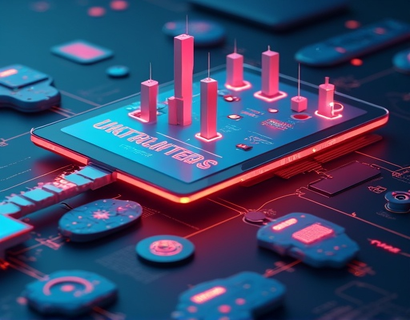Unleashing Advanced Digital Transformation: The Synergy of AI and Crypto for Early Adopters and Tech Innovators
The intersection of Artificial Intelligence (AI) and cryptocurrency represents a frontier of digital transformation, offering unprecedented opportunities for early adopters and tech innovators. This article delves into the profound impact of integrating these advanced technologies, focusing on how they can enhance security, efficiency, and innovation. By exploring the seamless fusion of AI and crypto, we aim to provide a comprehensive guide for those looking to elevate their online presence and capitalize on the rapidly evolving digital landscape.
The Emergence of AI in Cryptocurrency
The integration of AI into the cryptocurrency space has been transformative. Initially, cryptocurrencies were seen as a decentralized alternative to traditional financial systems, but the addition of AI has expanded their utility and appeal. AI algorithms can analyze vast amounts of data to predict market trends, optimize trading strategies, and enhance security measures. For early adopters, this means access to more sophisticated tools that can provide a competitive edge in the crypto market.
One of the key areas where AI has made a significant impact is in market prediction. Traditional methods rely on historical data and basic statistical models, which often fall short in capturing the complex dynamics of crypto markets. AI, with its machine learning capabilities, can process and analyze real-time data from various sources, including social media sentiment, news articles, and transaction patterns. This comprehensive analysis enables more accurate predictions, helping traders make informed decisions.
Enhancing Security with AI
Security is a paramount concern in the crypto world, and AI plays a crucial role in fortifying defenses against cyber threats. Traditional security measures, such as firewalls and antivirus software, are increasingly inadequate against sophisticated attacks. AI-driven security solutions, on the other hand, can detect and respond to threats in real-time, adapting to new vulnerabilities as they emerge.
For instance, AI can monitor blockchain transactions for unusual patterns that may indicate fraudulent activity. By analyzing transaction data, AI algorithms can identify anomalies and flag potential security breaches before they cause significant damage. This proactive approach to security not only protects individual users but also enhances the overall integrity of the crypto ecosystem.
AI-Driven Smart Contracts
Smart contracts are self-executing contracts with the terms of the agreement directly written into code. The integration of AI into smart contracts can further enhance their functionality and reliability. AI can be used to dynamically adjust contract terms based on real-time data, ensuring that agreements remain fair and adaptive to changing conditions.
For example, in decentralized finance (DeFi) applications, AI can analyze market conditions and automatically modify loan interest rates or collateral requirements. This flexibility reduces the risk of contract failures and ensures that all parties benefit from the most current market data. For tech innovators, this means more robust and efficient financial instruments that can be integrated into a wide range of applications.
Efficiency in Crypto Operations
AI can significantly streamline various crypto operations, from wallet management to transaction processing. AI-powered wallets can optimize storage and management of digital assets, providing users with insights into their portfolio performance and suggesting strategies to maximize returns. These wallets can also automate routine tasks, such as rebalancing portfolios or executing trades based on predefined criteria, saving users time and reducing the risk of human error.
In the realm of transaction processing, AI can enhance the speed and efficiency of blockchain networks. By optimizing the way transactions are validated and recorded, AI can reduce congestion and lower transaction fees. This is particularly beneficial for users who require fast and cost-effective transactions, such as businesses engaging in cross-border payments or micropayments.
Personalized User Experiences
The combination of AI and crypto enables the creation of highly personalized user experiences. AI algorithms can analyze user behavior and preferences to tailor recommendations and services. For instance, a crypto exchange powered by AI can offer personalized investment advice based on a user's trading history, risk tolerance, and market conditions. This level of personalization not only enhances user satisfaction but also fosters greater engagement and loyalty.
Moreover, AI can improve customer support through chatbots and virtual assistants. These AI-driven tools can handle a wide range of inquiries, from account management to technical support, providing users with quick and accurate assistance around the clock. This not only enhances the user experience but also reduces the operational costs for crypto platforms.
Innovative Financial Products
The synergy of AI and crypto has given rise to innovative financial products that were previously unimaginable. AI-driven trading bots, for example, can execute complex trading strategies with precision and speed, outperforming traditional algorithms. These bots can adapt to market conditions in real-time, executing trades based on a multitude of factors, including technical indicators, news sentiment, and macroeconomic data.
Another innovative product is AI-powered stablecoins, which use machine learning to maintain price stability. By analyzing market data and adjusting supply dynamically, these stablecoins can provide a more stable store of value compared to traditional cryptocurrencies. This stability is crucial for businesses that need a reliable unit of account for transactions and savings.
Building a Robust Ecosystem
For early adopters and tech innovators, building a robust ecosystem that integrates AI and crypto is essential for staying ahead in the digital landscape. This involves not only adopting existing AI and crypto solutions but also contributing to the development of new technologies. By participating in open-source projects, contributing to research, and collaborating with other innovators, individuals can drive the evolution of these technologies and create a more interconnected and efficient digital environment.
Moreover, fostering a community around AI and crypto initiatives can amplify the impact of these technologies. Communities can serve as platforms for knowledge sharing, resource exchange, and collective problem-solving. By building a strong community, early adopters can attract like-minded individuals and organizations, creating a network effect that accelerates innovation and adoption.
Challenges and Considerations
While the potential of AI and crypto is vast, there are several challenges and considerations that early adopters and tech innovators must address. One of the primary concerns is regulatory compliance. The crypto space is still largely unregulated, and the integration of AI adds another layer of complexity. It is crucial to stay informed about regulatory developments and ensure that all activities comply with local and international laws.
Another challenge is the technical expertise required to effectively integrate AI and crypto. These technologies are complex and require a deep understanding of both domains. Early adopters should invest in education and training to build the necessary skills or collaborate with experts who can guide the integration process.
Additionally, there is the issue of scalability. As the number of users and transactions grows, AI and crypto systems must be able to scale efficiently without compromising performance. This requires careful planning and investment in infrastructure to handle increasing loads and ensure seamless operations.
Conclusion
The integration of AI and crypto represents a powerful force for digital transformation, offering early adopters and tech innovators a wealth of opportunities. By enhancing security, efficiency, and innovation, these technologies can elevate online presence and maximize potential in the rapidly evolving digital landscape. As the ecosystem continues to grow and mature, those who embrace this synergy will be well-positioned to lead the charge in shaping the future of digital technologies.










































